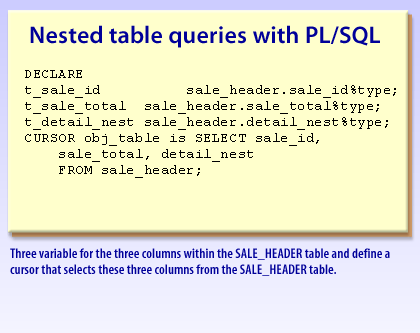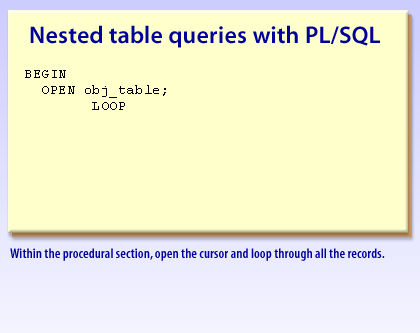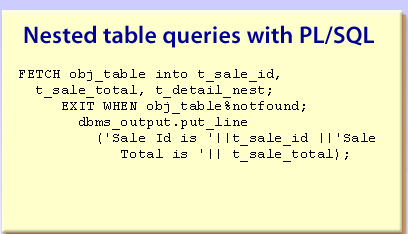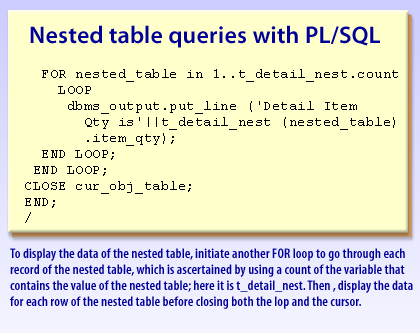| Lesson 6 | Nested table queries with PL/SQL |
| Objective | Write a PL/SQL procedure that retrieves nested table data. |
PL/SQL Procedure that retrieves a nested table using a PL/SQL Construct
In this lesson, we will write a PL/SQL block to query an object table that has a nested table.
Let us look at the
The following series of images explains the results of applying this query to the
Let us look at the
SALE_HEADER table closely. This table includes two basic parts, the SALE_HEADER object type and the SALE_DETAIL object type. The SALE_DETAIL object type is a nested table, which is referred as a column within the SALE_HEADER object table. A parent-child (one-to-many) relationship exists between these two object types.Querying an object table with a nested table within it, the SALE_HEADER table, for instance, requires a simple cursor and a FOR LOOP structure. However, to retrieve the data from the nested table, we must define another FOR LOOP because the nested table has more than one record for every instance of the object table. The following series of images explains the results of applying this query to the
SALE_HEADER table:
Querying Oracle Nested Table[Process Description]

DECLARE t_sale_id sale_header.sale_id%type;Three variables for the three columns within the SALE_HEADER table and define a cursor that selects these three columns from the SALE_HEADER table.

BEGIN OPEN obj_table; LOOPWithin the procedural section, open the cursor and loop through all the records.

FETCH obj_table into t_sale_id, t_sale_total, t_detail_nest;Next, fetch the data into the variables defined within the declaration section and display the data pertaining to the attributes of the object table by using DBMS _OUTPUT.

FOR nested_table in 1..t_detail_nest.count LOOPTo display the data of the nested table, initiate another FOR loop to go through each record of the nested table, which is ascertained by using a count of the variable that contains the value of the nested table, here it is t_detail_nest.
The following section discusses how to build a PL/SQL block that queries a nested table.
You will query the
SALE_HEADER table and its attributes, including the nested table within it, and display the data by using DBMS_OUTPUT.
Oracle PL-SQL Block
- Connect to the database by using
PETSTOREas the User Name,GREATPETSas the Password, andMYDBas the Host String. Approve the entries. - Declare variables for all the columns within the
SALE_HEADERtable. Name each variable as the column name prefixed witht_. Next, enter the query for a cursor that selects all the columns fromSALE_HEADER, restricted to records only wheresale_idis36. - Open the cursor and loop through the records.
- Fetch the records into the variables and display the data for the object table attributes by using
DBMS_OUTPUT. The display should be in two lines, where the first line is the header containing the columns displayed and the second line is the data. - Retrieve data from a nested table column and display it by using
DBMS_OUTPUT. - End the first
FORloop, close the cursor, and end the PL/SQL block. - Compile the PL/SQL block.
- SQL*Plus now displays the result of the compilation of your block. This is the end of the simulation. Click the Exit button.
PL/SQL Basics
A PL/SQL block is a complete section of PL/SQL code. A PL/SQL program is made up of one or more blocks that logically divide the work.
Blocks can even be nested within other blocks. The following description contains a full discussion on block structure.
PL/SQL Block Syntax Rules
Syntax and rules govern what you can and cannot do in PL/SQL. While the following syntax and programming standards alone do not make a
program good, failure to understand the rules of the language can certainly make a program bad. In this module, we discuss the basic
principles of the language, including PL/SQL block structure
The basic program unit in PL/SQL is called a block. Blocks contain sets of instructions for Oracle to execute, display information to the screen, write to files, call other programs, manipulate data, and more. All PL/SQL programs are made of at least one block. Methods of implementation range from programs that are executed one time only and are not stored anywhere, to blocks that are stored in the database for later use. Blocks support all DML statements, and using Native Dynamic SQL (NDS) or the built-in DBMS_SQL, they can run DDL statements.
- Variable declarations
- Literals, characters, and reserved words
- Data types available for PL/SQL
- Wrapper utility to hide code
The basic program unit in PL/SQL is called a block. Blocks contain sets of instructions for Oracle to execute, display information to the screen, write to files, call other programs, manipulate data, and more. All PL/SQL programs are made of at least one block. Methods of implementation range from programs that are executed one time only and are not stored anywhere, to blocks that are stored in the database for later use. Blocks support all DML statements, and using Native Dynamic SQL (NDS) or the built-in DBMS_SQL, they can run DDL statements.
The next lesson will wrap up this module.